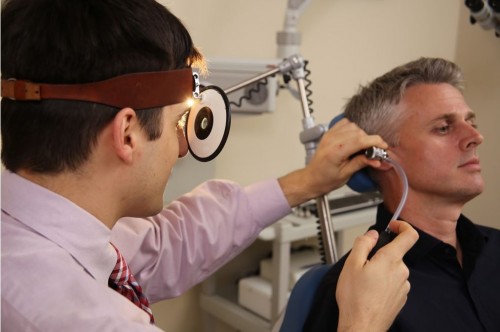Is ear pain affecting your daily life?
The causes of ear pain can be difficult to determine.
That’s because an earache, also known as “otalgia”, falls into two main categories: primary and secondary. Anyone who’s had an ear infection has experienced a primary earache. That’s when the pain is related to a problem inside the ear.
“Referred” or secondary ear pain, originates outside of the ear. It travels from a neighboring part of the head or neck and may involve the jaw, teeth, sinuses, throat, or neck.
Symptoms depend on whether an earache is caused by infection, injury or inflammation.
Ready for Relief? Make an Appointment Now > 
The underlying causes of ear pain vary, but people with chronic pain may have:
- Discomfort with chewing food or opening their mouth
- Difficulty with neck pain
- Stuffy or congested nose
- Sinus infections
- Problems with balance
- Decreased hearing
- Aching facial pain
- Tenderness of the jaw
- Clicking or popping of the jaw joint
- Irritating hoarseness or sore throat
Ear pain can erode your quality of life because it’s often unpredictable in duration, frequency and severity. Nagging earaches make even normal activities like eating or talking uncomfortable.
If you or a loved one suffers from ear pain that’s been difficult to pinpoint, our thorough approach can help. Before deciding on a treatment, we’ll conduct a detailed diagnostic search for the underlying cause of your ear pain.
Let Ashford Clinic help alleviate your ear pain
“I can now enjoy a steak dinner without aspirin on the side.”
Hearing a comment like that makes us smile. Giving patients the ability to enjoy life free from severe pain validates our commitment to provide thorough, personalized care.
If you or a loved one suffers from ear pain that is new or recurring, please contact us now to make an appointment.
What causes ear pain?
Ear pain can result from a variety of causes, but the three most common are:
- TMJ Syndrome. The temporomandibular joint (TMJ) is the jaw joint. TMJ syndrome is a condition in which the patient experiences ear pain when moving the jaw during regular activities like talking or chewing. TMJ syndrome is often caused by stress and teeth grinding. Pain can be severe, radiating into the neck, and a popping or locking jaw is also common.
- Eustachian Tube Dysfunction. When the middle ear is unable to pressurize properly, it pulls the eardrum inward in a manner that can cause pressure or pain. While the pain comes from directly within the ear, the cause of the dysfunction is often nasal allergies, chronic sinusitis or throat irritation. Left untreated, this condition may lead to hearing loss, tinnitus or vertigo.
- Referred Pain from the Throat. The glossopharyngeal nerve gives sensation to the throat through a special branch called Jacobson’s nerve that passes through the middle ear. Similarly, the vagus nerve gives sensation to the top of the voice box, but also has a branch that leads to the external ear or ear canal. Because of the related nerve connections, the brain sometimes misinterprets irritation in the back of the throat as ear pain.
What is the treatment for ear pain?
For ear pain associated with TMJ Syndrome, anti-inflammatory medicine, warm compresses, a soft diet and a bite guard can often give relief.
If symptoms continue, a dentist or oral surgeon who specializes in TMJ dysfunction can provide advanced interventions such as customized bite blocks and prostheses.
For ear pain associated with Eustachian Tube Dysfunction, it’s important to treat the underlying causes of inflammation with either anti-acid medication, nasal steroid sprays or antibiotics. This will usually reduce the swelling around the eustachian tube and restore its function.
If ear pain continues, a tube can be placed in the eardrum through a very small hole to alleviate the pain. A new treatment may include balloon dilation of the eustachian tube, which can result in long lasting improvement in eustachian tube dysfunction.
For referred ear pain from the throat, the only effective approach is to treat the underlying inflammatory or irritating problem. This may include tonsil and throat infections, rheumatoid arthritis, acid reflux, or voice box cancers.
When is surgery an option for ear pain?
There are only a few instances in which surgery is considered for the secondary ear pain as outlined above. Typically, this would require referral to a dentist or oral surgeon.
For patients with TMJ syndrome, minimally invasive joint surgery can be effective at alleviating pain in certain situations.
When initial treatments for Eustachian tube dysfunction fails, an ear tube can be surgically placed in the ear drum to alleviate pain. An ear tube is a low-risk, minimally invasive procedure performed in the office. Balloon dilation of the Eustachian tube is also a new treatment that can provide lasting relief of symptoms. This is often performed if the sinuses are being treated at the same time.


